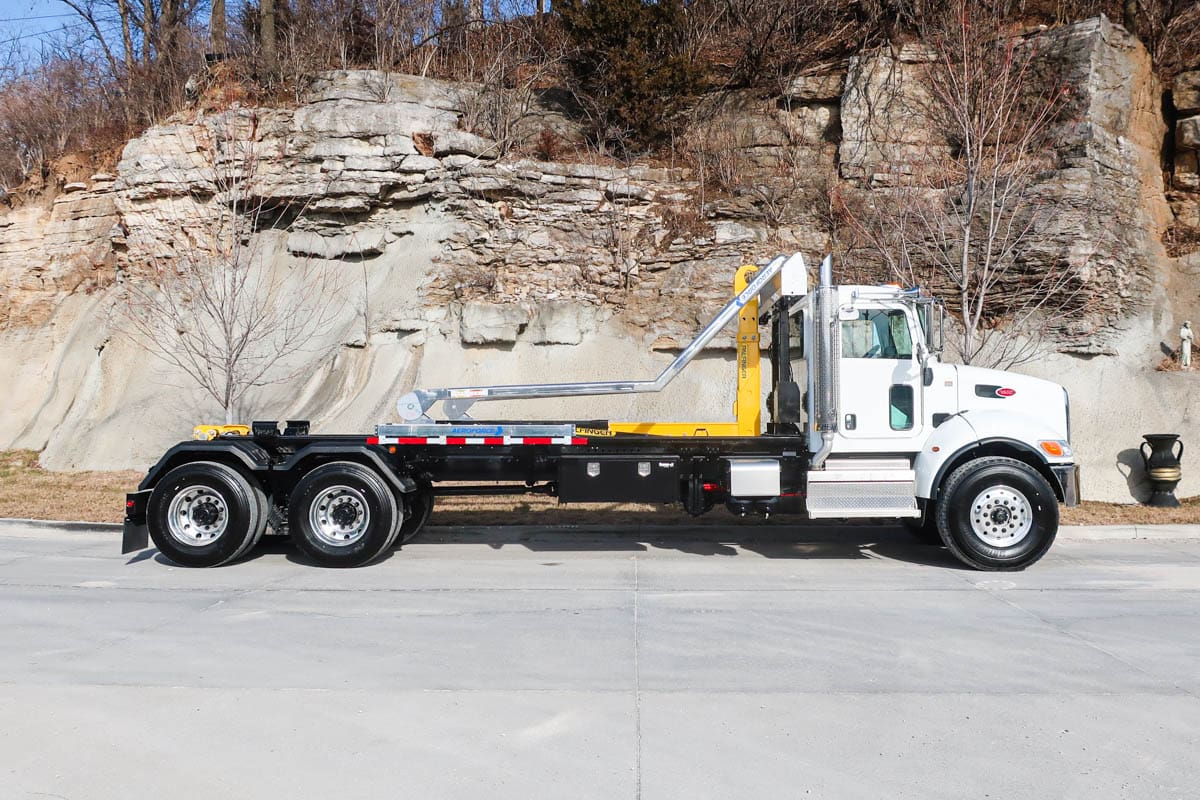
Hooklifts are a safe and versatile type of roll-off truck. They are simple and efficient to use for your container moving needs, but only if you know how to properly use them. Below are the step-by-step procedures of how to unload and load containers using a Palfinger T50 hook lift truck with an AeroForce tarp. These will vary depending on the particulars of the unit you’re using, but will give you the general idea of proper hooklift hoist operations for the Palfinger T Series.
Loading a Container
- Familiarize yourself with all safety procedures and operator manuals. This is a necessary first step before operating any piece of equipment.
- Engage the PTO. The operator controls are on a pendant with 2 thumb switches.
- To begin loading, slide the jib all the way to the rear position. This will get the hoist out of dump mode and into load and unload mode.
- Use the switch to start bringing container onto truck
- Bring the jib back over center to begin loading the container. You can roll the truck underneath the container, or the hook itself will pull the container up and over and slowly forward. One of the biggest perks about these hooklifts is that the operator isn’t required to get in or out of the truck to do this. Before the container is on the truck, the sills must be lined up with the rear rollers and either guided on with the flanges or automatically lined up before the wheels of the container come off the ground. If it’s not properly lined up, the operator can drive forward and steer the container to line them up. The container then slowly transitions onto the truck from the ground, and the operator continues to bring the hoist down.
- The jib is now extended forward, and you can pull the container into the transport position.
Using a Tarper
Tarping the Container
- The AeroForce tarper comes with remote control. You turn the remote on by hitting B and A.
- Verify that there are no overhead obstructions before closing the container. The arms of the tarping system will go above the container, and you don’t want them to collide with anything.
- The buttons on the remote just correspond with what functions are written (up, down, forward, etc.). To close the container, raise the gantry, and move the arms to close the the tarp over the whole top of the container.
- Put the gantry back in the home position prior to travel. The remote automatically goes to sleep when you’re finished using it.
Removing the Tarp
- Once again, check that there aren’t any overhead obstructions.
- Using the remote, raise the gantry above the height of the container.
- Uncover the container by moving the arms.
- Adjust the pivot point to rest the arms back in the cradle of the gantry.
Unloading a Container
- Slide the jib all the way back to the home position. The jib pushes the container off when in the home position.
- This procedure is just the opposite of the loading process. The hook transitions over the center to the rear. The rollers then pivot to support the sills of the container.
- At this point, the hook lift truck can be put in neutral to place the container or you can drive out from under the container, depending on the ground conditions and where container needs to be placed.
- Once the container is placed on the ground, lower the hook. You are then good to drive away from the container and get ready for your next job!
Palfinger T50 Hook Lift Demonstration
If you have any further questions about the operation of Palfinger T50 hooklifts, or any other roll-off equipment, reach out and our experts will give you the guidance you need.

